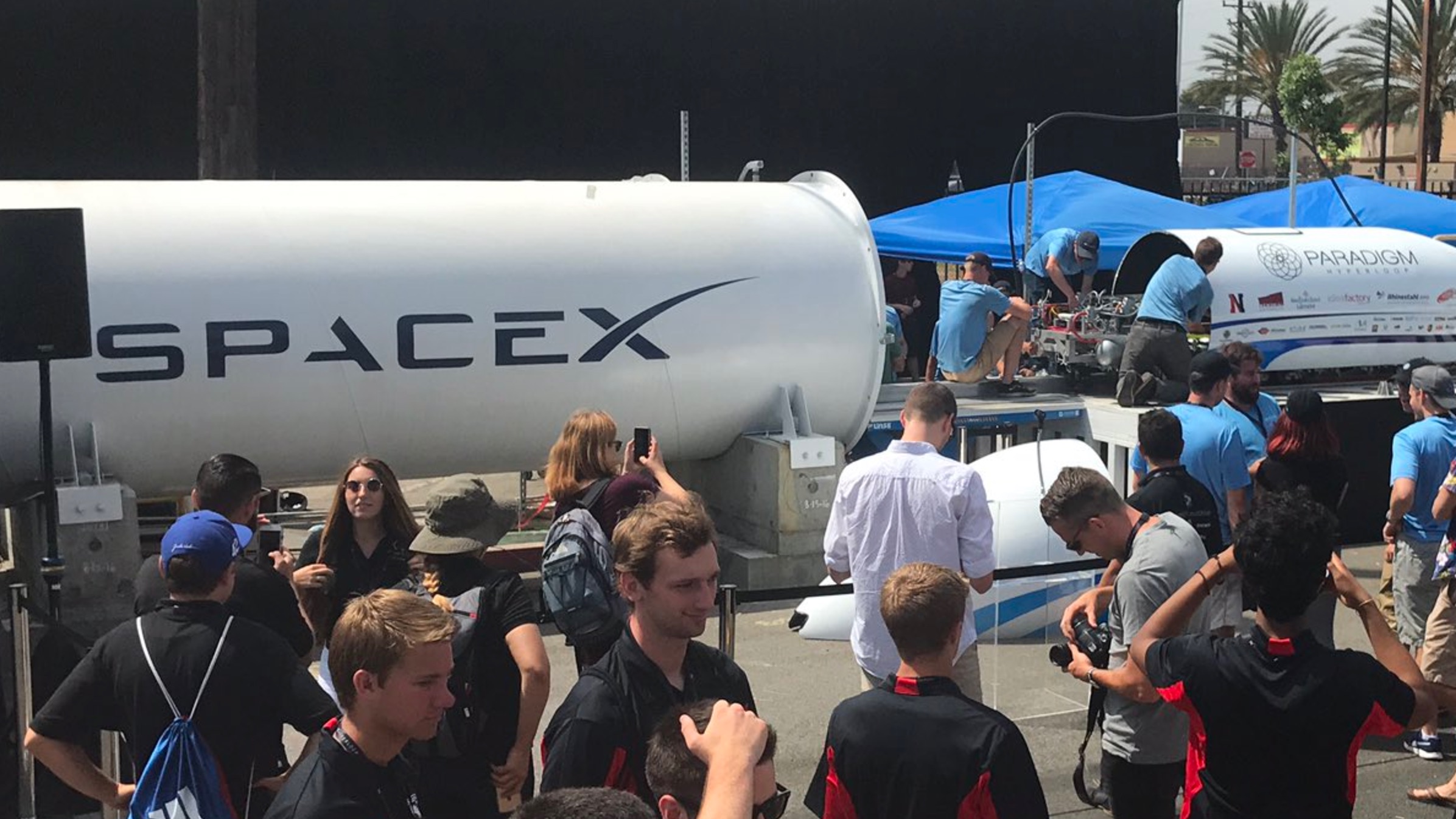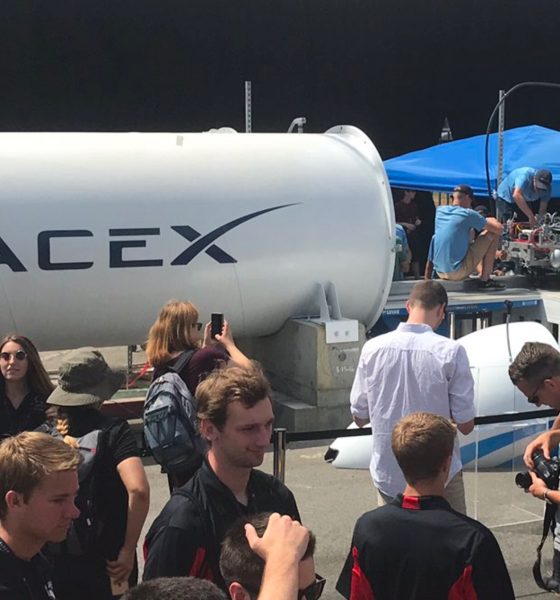

News
SpaceX Hyperloop Competition: Top 3 teams duke it out for fastest pod
Hawthorne councilmembers, members of the California Assembly, and Hawthorne Mayor Alex Vargas were in attendance at the headquarters of SpaceX and The Boring Company for their jointly-hosted Hyperloop Competition 2.
The second such Hyperloop competition sponsored by Elon Musk, the eight months that separated them were filled to the brim with press coverage of The Boring Company (TBC), which has begun to seriously develop an experimental tunnel beneath a central street in Hawthorne, CA. Most intriguingly, TBC publicly acknowledged that it is now pursuing the development of its own form of Hyperloop technology, originally developed and released as a white paper by Elon Musk, albeit with tunnels rather than above-ground vacuum tube constructs.
Update: Watch Elon Musk award this team for having the fastest Hyperloop pod at 202 mph
The second competition was focused on one goal, above all others: top speed. The final three teams chosen for testing in SpaceX’s mile-long vacuum tube were as international as ever. Paradigm Hyperloop, a continuation of the Openloop team from Competition 1, is composed of 26 students from the northeastern U.S. and Canada, designed a pod that made use of air bearings to levitate and was intended to travel as fast as 200 mph through SpaceX’s test track. While not yet officially confirmed, a livestream suggested that their pod reached a maximum speed of approximately 100 km/h or 62 mph. While nowhere near its purported top speed, a member of Paradigm Hyperloop said that the team’s pod “levitated perfectly” and that the test generally went great. Their pod was one of the largest, weighing in at almost a metric ton.
SwissLoop, a team of 40 or so students from Swiss university ETH Zurich, developed a pod that levitated with permanent magnets and was propelled by compressed air, sort of like a rocket. SwissLoop’s SpaceX adviser, a mechanical engineer focused on reusing Falcon 9s on normal days, praised the group’s engineering and construction of the pod during a livestream on Facebook. SwissLoop experienced some technical difficulties while Musk waiting to provide the countdown in Swiss German, and he quipped about connectivity issues that the team was having with their pod. Musk later announced that due to those technical difficulties, SwissLoop’s pod would be removed for troubleshooting and WARR Hyperloop would conduct the second live test.
Pod problem. Developing futuristic transport isn't quick. #Hyperloop pic.twitter.com/QJAngYvCbP
— Jack Stewart (@stewart_jack) August 27, 2017
WARR Hyperloop, the victors of the first Competition, prepared their Pod ii to be tested on Sunday afternoon. One of the smallest pods at only 190 lb, the vehicle was intended to have a top speed of approximately 225 mph – a speed it was reported to be capable of reaching in 12 seconds. Designed by students from the Technical University of Munich, the pod was propelled with a 50 kW electric motor connected to polyurethane wheels. While the method of levitation was not specified, it is understood to be a system of permanent magnets similar to SwissLoop’s implementation. WARR is a German organization and stands for Scientific Workgroup for Rocketry and Spaceflight in English.
Elon Musk somewhat controversially revealed that The Boring Company had received “verbal approval” for an underground Hyperloop between Washington D.C. and New York City, appearing to acknowledge some form of back-room deal with the federal government. He later clarified in a series of tweets and replies that the approval was extremely preliminary and unofficial and that The Boring Company was hard at work beginning to form relationships with the numerous municipalities that would be involved along the proposed route. The several Hyperloop-related companies that formed following Musk’s white paper have been reluctant to make room for a new, Musk-headed competitor in the ring, but The Boring Company is aggressively pushing ahead with their demonstration tunnel in Hawthorne, CA and has successfully applied for the initial permits that will be required.
Mirroring Elon’s typically positive opinion of competition, he bid Hyperloop One and all other companies trying to revolutionize transportation the best of luck during Competition 2. Competition 2 is guaranteed to provide SpaceX and The Boring Company an inside glance at some of the best emerging engineering talent. Hosting the competition is quite possibly the most suave and effective method of recruitment one can readily imagine, with all promising teams generally being given private tours of both The Boring Company and SpaceX facilities.
I hope they and any others trying to advance transport technology succeed
— Elon Musk (@elonmusk) August 27, 2017
Meanwhile, stay tuned for the two max speed pod tests to come later this afternoon. There is no live coverage from SpaceX itself, but SwissLoop has been kind enough to livestream several of the main events on their Facebook page. You can also follow a live Facebook stream here. Follow along live there and check back at Teslarati for coverage of the events!

News
Tesla (TSLA) receives “Buy” rating and $551 PT from Canaccord Genuity
He also maintained a “Buy” rating for TSLA stock over the company’s improving long-term outlook, which is driven by autonomy and robotics.

Canaccord Genuity analyst George Gianarikas raised his Tesla (NASDAQ:TSLA) price target from $482 to $551. He also maintained a “Buy” rating for TSLA stock over the company’s improving long-term outlook, which is driven by autonomy and robotics.
The analyst’s updated note
Gianarikas lowered his 4Q25 delivery estimates but pointed to several positive factors in the Tesla story. He noted that EV adoption in emerging markets is gaining pace, and progress in FSD and the Robotaxi rollout in 2026 represent major upside drivers. Further progress in the Optimus program next year could also add more momentum for the electric vehicle maker.
“Overall, yes, 4Q25 delivery expectations are being revised lower. However, the reset in the US EV market is laying the groundwork for a more durable and attractive long-term demand environment.
“At the same time, EV penetration in emerging markets is accelerating, reinforcing Tesla’s potential multi‑year growth runway beyond the US. Global progress in FSD and the anticipated rollout of a larger robotaxi fleet in 2026 are increasingly important components of the Tesla equity story and could provide sentiment tailwinds,” the analyst wrote.
Tesla’s busy 2026
The upcoming year would be a busy one for Tesla, considering the company’s plans and targets. The autonomous two-seat Cybercab has been confirmed to start production sometime in Q2 2026, as per Elon Musk during the 2025 Annual Shareholder Meeting.
Apart from this, Tesla is also expected to unveil the next-generation Roadster on April 1, 2026. Tesla is also expected to start high-volume production of the Tesla Semi in Nevada next year.
Apart from vehicle launches, Tesla has expressed its intentions to significantly ramp the rollout of FSD to several regions worldwide, such as Europe. Plans are also underway to launch more Robotaxi networks in several more key areas across the United States.
News
Waymo sues Santa Monica over order to halt overnight charging sessions
In its complaint, Waymo argued that its self-driving cars’ operations do not constitute a public nuisance, and compliance with the city’s order would cause the company irreparable harm.

Waymo has filed a lawsuit against the City of Santa Monica in Los Angeles County Superior Court, seeking to block an order that requires the company to cease overnight charging at two facilities.
In its complaint, Waymo argued that its self-driving cars’ operations do not constitute a public nuisance, and compliance with the city’s order would cause the company irreparable harm.
Nuisance claims
As noted in a report from the Los Angeles Times, Waymo’s two charging sites at Euclid Street and Broadway have operated for about a year, supporting the company’s growing fleet with round-the-clock activity. Unfortunately, this has also resulted in residents in the area reportedly being unable to sleep due to incessant beeping from self-driving taxis that are moving in and out of the charging stations around the clock.
Frustrated residents have protested against the Waymos by blocking the vehicles’ paths, placing cones, and “stacking” cars to create backups. This has also resulted in multiple calls to the police.
Last month, the city issued an order to Waymo and its charging partner, Voltera, to cease overnight operations at the charging locations, stating that the self-driving vehicles’ activities at night were a public nuisance. A December 15 meeting yielded no agreement on mitigations like software rerouting. Waymo proposed changes, but the city reportedly insisted that nothing would satisfy the irate residents.
“We are disappointed that the City has chosen an adversarial path over a collaborative one. The City’s position has been to insist that no actions taken or proposed by Waymo would satisfy the complaining neighbors and therefore must be deemed insufficient,” a Waymo spokesperson stated.
Waymo pushes back
In its legal complaint, Waymo stated that its “activities at the Broadway Facilities do not constitute a public nuisance.” The company also noted that it “faces imminent and irreparable harm to its operations, employees, and customers” from the city’s order. The suit also stated that the city was fully aware that the Voltera charging sites would be operating around the clock to support Waymo’s self-driving taxis.
The company highlighted over one million trips in Santa Monica since launch, with more than 50,000 rides starting or ending there in November alone. Waymo also criticized the city for adopting a contentious strategy against businesses.
“The City of Santa Monica’s recent actions are inconsistent with its stated goal of attracting investment. At a time when the City faces a serious fiscal crisis, officials are choosing to obstruct properly permitted investment rather than fostering a ‘ready for business’ environment,” Waymo stated.
News
Tesla FSD v14.2.2 is getting rave reviews from drivers
So far, early testers have reported buttery-smooth drives with confident performance, even at night or on twisty roads.

Tesla Full Self-Driving (Supervised) v14.2.2 is receiving positive reviews from owners, with several drivers praising the build’s lack of hesitation during lane changes and its smoother decision-making, among others.
The update, which started rolling out on Monday, also adds features like dynamic arrival pin adjustment. So far, early testers have reported buttery-smooth drives with confident performance, even at night or on twisty roads.
Owners highlight major improvements
Longtime Tesla owner and FSD user @BLKMDL3 shared a detailed 10-hour impression of FSD v14.2.2, noting that the system exhibited “zero lane change hesitation” and “extremely refined” lane choices. He praised Mad Max mode’s performance, stellar parking in locations including ticket dispensers, and impressive canyon runs even in dark conditions.
Fellow FSD user Dan Burkland reported an hour of FSD v14.2.2’s nighttime driving with “zero hesitations” and “buttery smooth” confidence reminiscent of Robotaxi rides in areas such as Austin, Texas. Veteran FSD user Whole Mars Catalog also demonstrated voice navigation via Grok, while Tesla owner Devin Olsen completed a nearly two-hour drive with FSD v14.2.2 in heavy traffic and rain with strong performance.
Closer to unsupervised
FSD has been receiving rave reviews, even from Tesla’s competitors. Xpeng CEO He Xiaopeng, for one, offered fresh praise for FSD v14.2 after visiting Silicon Valley. Following extended test drives of Tesla vehicles running the latest FSD software, He stated that the system has made major strides, reinforcing his view that Tesla’s approach to autonomy is indeed the proper path towards autonomy.
According to He, Tesla’s FSD has evolved from a smooth Level 2 advanced driver assistance system into what he described as a “near-Level 4” experience in terms of capabilities. While acknowledging that areas of improvement are still present, the Xpeng CEO stated that FSD’s current iteration significantly surpasses last year’s capabilities. He also reiterated his belief that Tesla’s strategy of using the same autonomous software and hardware architecture across private vehicles and robotaxis is the right long-term approach, as it would allow users to bypass intermediate autonomy stages and move closer to Level 4 functionality.








